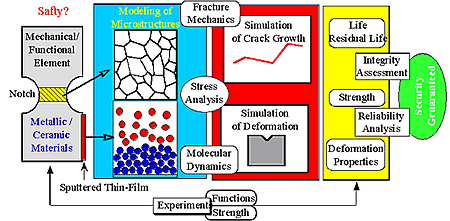Design for Materials to Create New Functions and Energy-Related Machinery
Theoretical and experimental investigations are carried out to establish the methodology for design of materials and machinery to be applied to the energy conversion. Works conducted in this group are summarized as follows; the fatigue simulation analysis for the fatigue design, the strength analysis of advanced ceramics and high performance thin-film coated materials, the microscopic deformation behavior and the associated constitutive relation of inelastic solid, the modeling of complex materials with gradient of a high order and the development of numerical procedure for the analysis of such a material, the analysis of non-steady thermo-mechanical process including phase transformation by using molecular dynamics and phase field model, and also its relevant investigation of algorithm. In the following, some representative studies are introduced.
Integrity Evaluation of Machinery and Elements
Most of failures in machinery and mechanical/functional elements made of metallic materials are caused by so-called fatigue of metallic materials. Experimental and theoretical investigations on fatigue phenomenon are conducted to prevent mechanical/functional elements or systems from fatigue failure and to control the evolution of fatigue damage so that persons’ safety can be improved in daily life. Ceramic materials are expected for their applications to electronic devices as functional materials and also to mechanical elements such as turbine brads for electric power generation or turbocharger in automobiles to be used at elevated temperature, while porous ceramics are candidates of functional usages such as catalysts to clean exhausted gas in automobiles and filters to remove dust in power generation systems by burning coal. However, the mechanical design of ceramic components should be reconsidered away from usually design methodology of metallic elements. Simulation procedures based on experimental works are developed to clarify the aforementioned problem so that the integrity of advanced ceramic components may be guaranteed in their services. In addition, physical properties of functional thin-films sputtered on metallic or ceramic substrates are also investigated by experiments and numerical analyses.

Inelastic Behavior of High Temperature Materials
In order to evaluate the safety assessment of high temperature machine components, deformation behavior of polycrystalline materials is investigated from both macroscopic and microscopic viewpoints. Crystal plasticity model is introduced into the finite element simulation code by which grain boundary sliding as well as surface roughness are evaluated. Experimental verification is also carried out on high temperature materials using SEM and AFM. Unified inelastic constitutive models are applied to the description of mechanical response in high temperature machine components. The strain gradient material theory is studied from the viewpoint of the generalized configurational force concept in nonlinear continuum mechanics.

Micro and Nanoscopic Simulation
Macroscopic properties of materials is affected by micro and nanoscopic behavior, such as dislocation or defects in atomistic scale, and microstructure and grain boundary in micro scale. In order to take these effects into account, the thermo-mechanical analyses in micro and nano scale is indispensable. Therefore, we perform the phase field simulations on dendritic crystal growth and poly-crystallization, and the molecular dynamics simulations on interfacial properties and phase transformation. Furthermore, we advance the multi-scale modeling for connecting these micro and nano-scale phenomena and macroscopic behavior.




